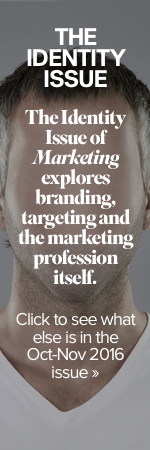Data use and why today’s loved brands risk becoming tomorrow’s hated ones
Share

A dissonance is emerging in society because of data, writes Steve Sammartino, and even much loved brands are at risk.
This article originally appeared in The Identity Issue, our October/November issue of Marketing magazine.
 I’ve had this definition of what a brand is for some time, and you won’t read it in a textbook. It doesn’t mention names, logos, marks or differentiation.
I’ve had this definition of what a brand is for some time, and you won’t read it in a textbook. It doesn’t mention names, logos, marks or differentiation.
None of these things are absolute necessities for a brand.
A common form of confusion is the so-called rebranding exercise, which most times is really a new logo or design of some sort. Occasionally the new logo design is the signal for change and a new era, but most often it’s just an expensive reset of pixels and stationery.
Here’s my simple version of what a brand really is:
A brand is a cognitive shortcut from which to make informed decisions.
Let’s break it down:
Cognitive
Over time we are informed as to what they do and what they believe in. Our mind creates a template about what this brand or company stands for. It’s based on the evidence from the total interactions we have, not just what their advertising says. (Banks of Australia please take note!) What a brand says about itself doesn’t count. It’s more about the actions – our interactions with it.
Shortcut
We know what it means in a heartbeat. All the experience we’ve had interacting with this brand creates a path that leads to the same location, a location in our minds. We know how to compare it to the alternative because our mind has already established what it means. The brand and that meaning become inextricably linked. We are exposed to a brand and it leads us to an immediate conclusion.
Informed decisions
We can choose if this brand is right for us, based on what we know about it. Some of the most powerful brands are so powerful because we know they are not right for us. The brand helps us make a decision to steer away from it, because it has a clear position on who it is for. The best brands don’t try and please everyone; they try and make the choice easier for the people for whom they are actually designed.
A brand is an identity based on the total market interactions people have with it. Whatever is put in the market becomes part of that brand experience. It is much more than what a brand says and looks like. In an age of corporate transparency and industrial tourism, a brand is increasingly what it does, regardless of what it says or claims.
The visual identity and brand interactions are like a reminder of the personality traits you’ve come to know about them. Like people we know, once we really know someone well, we actually start to forget what they look like. Their face is really a visual shortcut for the personality we know. Let’s think of some of the traits we often use to describe our friends:
‘Loving and affectionate’: They care about us and want to make us feel good and happy. They’re warm and will take extra steps to provide for us and make us feel good about ourselves.
‘Motivating and inspiring’: They get us excited about life. Make us feel more energetic than we did before we interacted with them. Make us believe we can be more and do more, that we have untapped potential.
‘Loyal and welcoming’: They make us feel part of something. They bring us into their world, their tribe. Regardless of how others view us, these friends make us feel important and a valued part of their cohort.
‘Cool and creative’: These friends are style masters and on the leading edge of now. Being around them brings us to a different place. They take us on an unexpected journey and surprise us with their perception and the way they put things together.
‘Intelligent and educational’: These friends love to show us how to do things. They know how to get things done and provide insight into how things can be with a little more thought and effort.
‘Trustworthy and honest’: We feel like we can really open up to these friends. They would never do anything to hurt us, and would protect our interests. We can share our fears and secrets with them, because they’d never use it against us.
You’ve probably noticed that nowhere on this list are the traits ‘secretive’, ‘deceptive’ or ‘duplicitous’. Here’s the kicker: if you’re not ‘trustworthy’ and ‘honest’, all of the other traits become meaningless. It’s a minimum requirement of important and valued relationships, both personal and commercial.
But today, in an age where data is spun into gold, this is the unfortunate path many brands and companies are heading down, a path where data is accumulated and cached for the sole commercial gain of the company gathering it.
I’m not saying data shouldn’t be collected and I’m not saying that tracking can be stopped now that the process is underway. I am saying that we need to remove the asymmetry in data. We need to stop stealing people’s identities and instead build transparent relationships.
Here’s a simple idea: every brand that collects data should have a page that anyone can log into to find out ‘What we know about you’, showing all the data, content and statistics listed about you, for you.
Imagine the props and free media a brand with the courage (another one of those good traits) would receive for doing this. Heck,
it could even become a forum for people to fill in the gaps with more accurate information that could assist both parties – the brand and consumer in doing business together. An open source data ethic to help solve each other’s problems. It would certainly be better than what we have today. A spy versus spy cold war of consumer espionage.
Humans are an incredible species. We have a wonderful sixth sense and when there is a cognitive dissonance in behaviour, eventually we work it out. Somewhere deep inside our neural network we sense it when things are not right. Maybe it’s our collective sentience that helps us uncover hidden bad behaviour.
There’s often a lag, but we always uncover it and this data asymmetry is going to bubble up to the surface and soon.
It happened with tobacco. It happened with pollution. It’s happening with the 1% wealth disparity.
And it will happen with data. There’s a cognitive dissonance emerging today with data. The seeds are being sown for brands many people love today to be hated tomorrow as much as petrochemical and tobacco companies are.
But this time, it isn’t a zero sum game. Data can and should be used for good. There are plenty of examples of data making life better. But we need to ensure that data becomes a form of participation and collaboration, and not one of deceit and control.
We’ve seen this behaviour before, when brands knew of the potential implications of their behaviour, but forged ahead in the pursuit of profit. Sometimes humans with good intentions can fall into the wormhole of short-term objectives. But it’s our job as marketers to be more than rent seeking capitalists, and realise we help shape the society we have to live in.
Society and the law need to catch up to what’s going on, and marketers should ask themselves what kind of persona their brand would be identified as. In the meantime, it’s probably better building something where the eventual removal of the data asymmetry won’t ruin your business model, but enhance it.
Image copyright: bakelyt / 123RF Stock Photo















